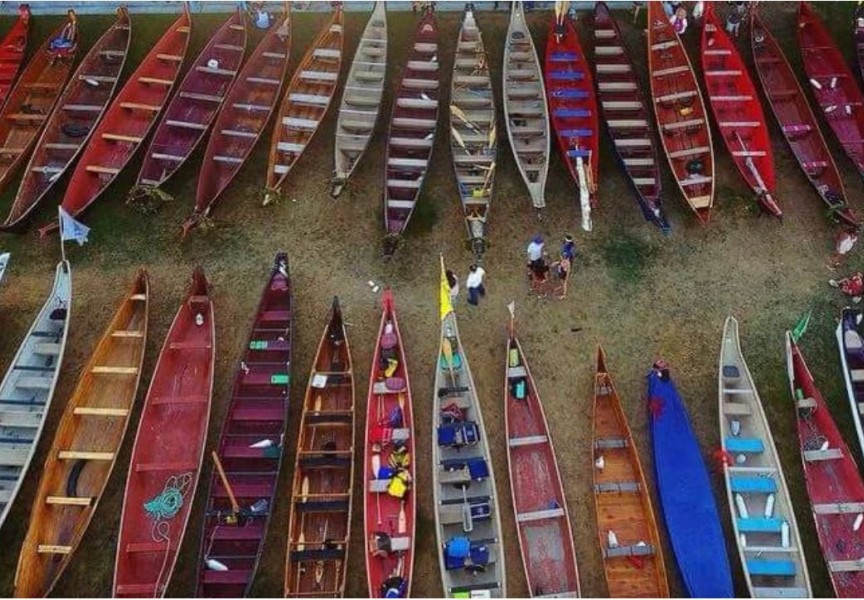About 40 members of Hupacasath First Nation took part in a community earthquake/tsunami emergency response exercise on March 5.
Participants first assembled at the House of Gathering at 10 a.m. for a briefing from project manager David Hewson.
“They are scheduled to return home at 11:15 to await the ‘alarm’ at noon and to build their preparedness kit,” Hewson told Ha-Shilth-Sa as the participants gathered and signed in.
At the briefing table was a box containing a stack of sealed envelopes – one for each participant.
“I have some instructions they are going to open up at noon,” Hewson said.
The instructions describe what one would experience in the event of a major “felt” earthquake.
“The ground begins to shake heavily for two to three minutes. Find a safe place to ‘Drop, Cover and Hold On’ in your home.”
In this exercise, the earthquake takes place offshore and close by, creating a massive tsunami. The electricity is out; there is no cellphone or Internet service and no running water.
“At 12:05 the Tsunami Siren Goes off and advises that a 20-metre high tsunami will reach the Alberni Inlet in 35 minutes.”
In this scenario, Hewson explained, the low-lying area of the Hupacasath reserve would be fully inundated by 12:40. The goal is for all members to assemble a grab-and-go bag and evacuate, by foot, to the mustering point at Gill School.
From Gill School, the survivors would walk up Beaver Creek Road to Pierce Road, which marks the edge of the inundation zone.
“The goal is to create some ‘muscle memory’ of what it takes to get out of the inundation zone and get to the mustering point,” Hewson explained. “From this, we will be able to identify what logistical gaps exist and how we can address them.”
The goal then is to determine what resources Hupacasath would be able to provide.
“Today we hope to identify the needs, but not necessarily address them.”
Tom Tatoosh said the live Tsunami Warning that took place in June 2005 was a reminder that the Big One will hit without warning. On that occasion, a Magnitude 7.4 earthquake off the coast of California triggered a snap tsunami alert at just after 9 p.m.
“We were fishing in the Somass when the Tsunami Warning went off,” Tatoosh recalled. “A handful of us kept fishing until the Harbour Commission came out and said ‘Tom – you guys are going to have to get out of the river.’”
From there it was a mad scramble to alert the other members, pull nets and get their boats out of the water. Because in the aftermath of a major tsunami, having a functional boat could be a matter of survival, he said.
Prior to Hewson’s briefing, Luke George of Tseshaht First Nation, noted that their Hupacasath neighbours were the first to organize a tsunami preparedness exercise.
“You guys will be our warning system,” he quipped.
Taking the stage, Hewson explained the rationale for holding a physical exercise.
“It’s like throwing a ball. You can think about it, but you don’t learn how to do it until you do it.”
Hewson emphasized safety as the first priority. For most, the evacuation meant walking along busy River Road, then up equally busy Beaver Creek Road, lugging a grab-and-go bag and, perhaps, herding young children.
Or pets.
“Do you have some set-up to transport your pet(s)? If not, it’s time to address that issue.”
Hewson emphasized that there would be no grade issued and there were no bad questions.
“I haven’t put out a bunch of obstacles. This is about ‘What do I need?’ ‘Where do I go?’”
Some questions:
Q: What if you live outside the flood plain (or are outside at the time of the quake)? A: Don’t try to make your way to the designated Hupacasath mustering point – just get to high ground.
Q: What about an earthquake without a tsunami? A: Assume a tsunami – get out of the inundation zone.
After the noontime ‘alarm,’ participants made their way to Gill School, with a wide range of bags and backpacks. Paulette Tatoosh was accompanied by her (huge) dog, Hooch. But Hooch isn’t her only pet, she noted.
“I realized I would need some sort of carryall for my cats,” she said, pointing to the stack of essentials she had lugged from home.
“Now, I’m looking at all this stuff and realizing you really have to pare it down.”
As the last of the Hupacasath members assembled, Hewson looked at his watch: 12:35.
“We have five minutes to get out of here!” he said, launching the short exodus up Beaver Creek Road to the safe-point at Pierce Road.
Minutes later, the participants gathered at the high point and surveyed what, in the event of a 20-metre tsunami, would be a mass of floating debris, broken houses, boats and automobiles similar to that left by the Good Friday Tsunami of 1964.
Back at the hall for the debriefing, Hewson stressed how critical it is to provide yourself with enough supplies to last for 72 hours without outside assistance. He asked for a show of hands:
“How many of you brought water? Food? A whistle? Rain Clothes? Medications?”
Tom Tatoosh said the exercise raised one unanticipated question.
“As we were walking along River Road, it occurred to me, in the event of a real evacuation, should we be bringing along our firearms, and how would that play out?” he said. Not for self-defense, but to hunt for food in the event of a prolonged emergency, he explained.
Tatoosh further suggested setting up the Hupacasath Woodlot with pre-positioned resources in the event of a major disaster requiring emergency housing.
One participant said she has already made a decision to make emergency preparedness a career path.
“I am going into Emergency Management in September, at the Justice Institute in Vancouver,” Julianne Hamilton said.
For the exercise, Hamilton and her younger sister packed a hefty-but-manageable bag, which she emptied out onto the table for photos.
“I have had this kit packed for years. I have everything on the list, so when we went home, we already had everything prepared. We had 30 minutes to kill, so we just sat and did our makeup until it was 12.”
Hamilton said while she was well prepared in advance, it was important to take part in the physical evacuation.
“I always wondered how long it would take us. We don’t drive. That was one of our main concerns: transportation. We live on River Road. We would take a shortcut through the back fields [to Gill School]. But seeing it right now, after all the rain and flooding, we would see that as a hazard.”
With that in mind, the Hamilton sisters stuck to the primary River Road route.
“I was really glad we did that. We timed it. It took us 21 minutes to get to Gill School.”
On June 7 through 10, Emergency Management BC, in partnership with the City of Port Alberni, Alberni-Clayoquot Regional District and First Nations governments, will conduct a full-scale earthquake/tsunami response exercise to simulate the worst-case scenario: a major earthquake in the Cascadia subduction zone, resulting in a major tsunami with only a short warning time.
Hewson said Hupacasath plans to take part in the upcoming program, bringing lessons learned from the March 5 community exercise.






